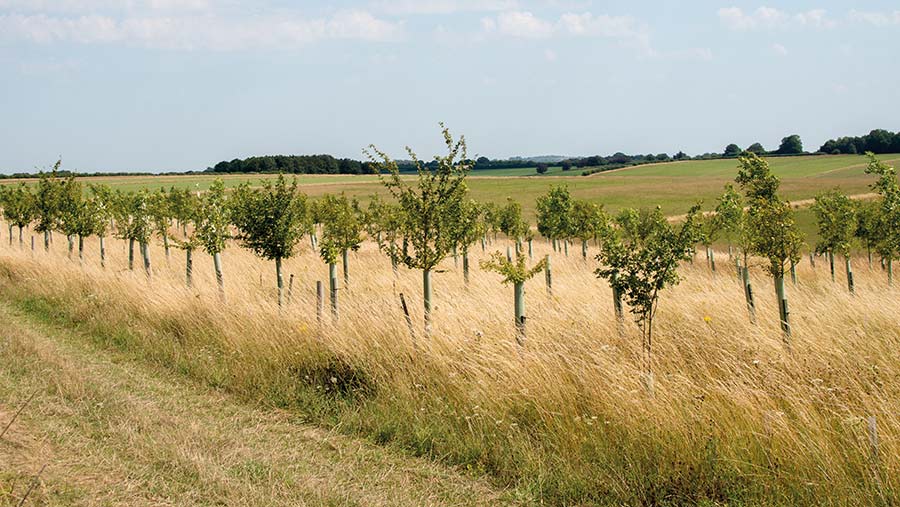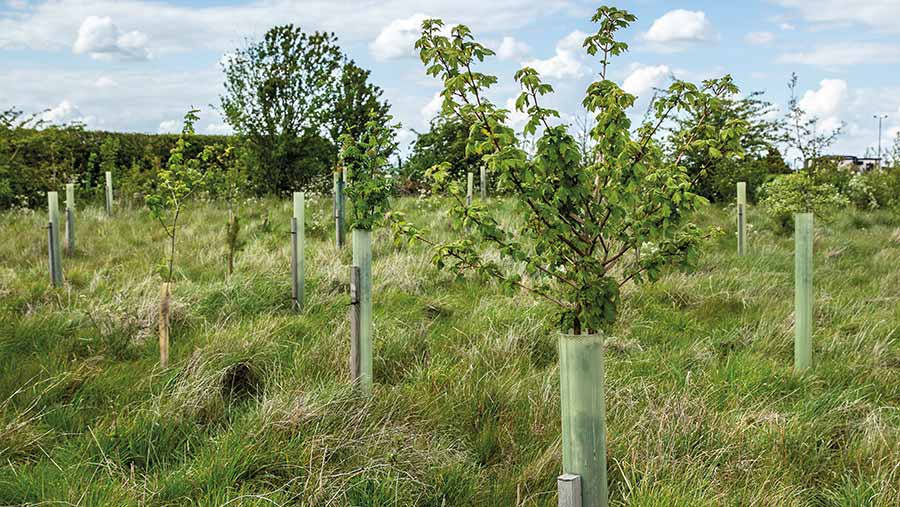How to plant the right tree in the right place on your farm
 © WTPL/Phil Lockwood
© WTPL/Phil Lockwood Many factors influence the best location for planting a new woodland, not least the reasons for wanting to do so in the first place.
These could include offering an alternative use for unproductive areas of farmland, providing shelter, creating new habitats, or preventing soil erosion or flooding, to name but a few.
Trees are increasingly seen as a key way of managing soil issues such as erosion, and mitigating the effects of flooding in high-risk areas.
Rain interception by canopies reduces the erosional effects of heavy rainfall, while root systems stabilise soil, help reduce run-off and store more water in the soil profile.
See also: Defra paves the way for more agroforestry in England
Research shows water infiltration rates can be 60 times higher within tree shelterbelts than in adjoining farmland.
However, when assessing any potential sites it is also vital to consider how the new planting will affect existing habitats and wildlife, as it must enhance rather than detract from the natural environment.
Assessing potential planting sites
Some areas that initially appear to be a good location for tree planting may not be suitable, so assess sites carefully and seek expert advice if you are in any doubt.
In some situations where there are habitats, species or archaeology that need protecting, it may be best to find an alternative planting site, whereas in other cases, there may be scope to incorporate features into woodland designs.
For example, it may be possible to include an open glade of species-rich grassland, or maybe an area of scrub around the boundary, as scrub is another important component of a diverse woodland habitat, particularly at the edge.
The Woodland Trust’s MOREwoods scheme offers help, advice and potential funding to farmers or landowners with larger planting projects of 500+ trees on at least 0.5ha of land.

© WTLP/Richard Faulks
Sensitive sites
There are five main areas where planting may not be recommended, or plans may have to be adapted:
1. Species-rich grassland
Grass fields that are difficult to access or manage with modern equipment, due to their size or steep slopes, may seem good locations for planting trees and, in many cases, that may be true.
Swards dominated by a few different grasses, especially ryegrass, or those that have been ungrazed for many years and have become rank are likely to be the best candidates for tree planting.
However, species-rich grassland has declined dramatically in the UK, so this should be protected.
Grassland that has not been ploughed, reseeded or had significant fertiliser or manure inputs in the past five years is much more likely to be species rich.
The proportion of broad-leaved plants (herbs) in the sward provides a useful indication of species diversity. If herbs account for more than 10% of the sward, check the site in spring for grassland indicator plants such as:
- Alkaline soils: Bird’s-foot trefoil, rockrose, cowslip, lady’s bedstraw, knapweed, thyme, scabious and salad burnet
- Acidic soils (for example, over sands, hilly uplands) Tormentil, heath bedstraw, harebell, betony, bitter vetch and pignut.
Remnant patches are often found on marginal ground, which may be the same areas targeted for woodland creation.
There could be scope to incorporate small areas of semi-natural habitats as glades within a new woodland to enhance the project, while on more extensive areas, scattered tree planting could create areas of wood pasture with exceptional conservation value.
Some important grassland habitats may not be very species rich, but still host important specimens.
For example, mossy or sedge- and rush-dominated swards can support grassland fungi such as waxcaps. It may be necessary to check the site in the autumn and in wet conditions to identify the presence of waxcap fungi.
Talk to your local Wildlife Trust for further advice, or go to Defra’s interactive Magic map for information about priority habitats and species in Britain.
2. Sites with rare or protected species
Avoid planting on sites with rare or legally protected species, such as certain types of orchid, adder’s tongue or sandwort.
Ancient trees, even dead ones, are also extremely important for conservation, and culturally, so do not plant trees where they will affect mature (veteran) trees as they grow.
Allow five times the girth of a large tree, or five metres beyond the canopy, as a minimum.
Also seek advice if there are ground-nesting birds (for example, lapwing, curlew or skylark) in the proposed planting area, as trees and woods can increase nest predation.
3. Archaeological sites
Tree planting must not damage important archaeology, but well-designed sites could enhance the setting of archaeological or historic features.
If you suspect there may be archaeology on your land, seek advice from the county archaeologist first.
4. Wetlands
Wetland (mire) habitats on waterlogged and/or peaty soils have also declined in the UK, so are another area that may not be suitable for tree planting.
Rushes, purple moor grass, taller sedges, sphagnum bog mosses and plants such as meadowsweet, marsh bedstraw and greater bird’s-foot trefoil all indicate wetland habitats.
5. Heathland
Heathland habitats are usually found on dry, often sandy or stony, shallow soils and may be indicated by the presence of heather, cross-leaved heath, bell heather, bilberry, mosses and very fine-leaved grasses.
Tailor species selection
Once a suitable site for planting has been found, you can then select the tree species that best match the requirements of how the wood will be used and the conditions in that location.
Consider factors such as soil type, water availability (including flooding risk), aspect, topography and climate.
Species such as alder and willow may be better suited to planting up a wet, flood-prone field corner than oak or beech.
Equally, native trees with nuts and berries such as rowan, hazel and beech would be better for attracting wildlife through the year.
Looking at which trees grow well in the surrounding area provides a useful indicator of the species that may thrive, but there could be others also suited to those conditions.
The Woodland Trust guide (PDF) can help you choose which species to plant.
Consider access requirements
When assessing potential sites, access is an important consideration, both for maintaining the woodland now and in the future, as well as for anyone using it, or if livestock are to be grazed among trees.
It is important to identify any legal rights of way or informal access routes within the site, as these will need to be integrated into the design of the new woodland.
Engaging and liaising with immediate neighbours is particularly important if access arrangements cross ownership boundaries and changes in use are likely to have a direct effect on neighbours.
You may decide to open the woodland to the public, either formally by establishing a new public right of way, or on a more temporary permissive basis.
Permissive access routes are not covered by the same long-term legal obligations as a public right of way and are generally not shown on maps, so need to be well signposted.
Consider the type of access and activities allowed (for example, walking, cycling or horse riding), as this will determine the design and infrastructure needed (including gates, styles, signage, paths and parking).
If you do not want to make your site publicly accessible, you could consider specialist access – for example, for education (such as a forest school).
Planning permission and environmental impact assessments
Planning permission is generally not required for new woodlands, but an environmental impact assessment (EIA) may be necessary, depending on the scale of the project and potential impact on the natural environment.
Planning rules, including the thresholds for when an EIA is required, vary across the UK, though, so it is best to check with the appropriate authority (see “Find out more online”).
For example, Forestry Commission England requires an EIA for new woodlands larger than 2ha (and in a sensitive area may require one for new woodlands larger than 0.5ha), while National Resources Wales has a threshold of more than 5ha.
The amount of information required within any EIA also varies depending on the scale and details of the project.
The basic level typically requires consultation with local stakeholders (for example, county archaeologists) and identifying any protected species or habitats that may be affected.
The potential effect on neighbouring properties or landowners must also have been considered, although many of these considerations are generally good practice for any new planting project.
Thanks to Woodland Trust, whose sponsorship made it possible for us to run this article. Farmers Weekly had full editorial control of its content.
Find out more online
Woodland Trust MOREwoods scheme

Trees should be in every farmer’s toolbox. They boost productivity, resilience and the health of the environment – with no need to trade off with production. Make your planting project a success with the Woodland Trust’s MOREwoods scheme, funded by Lloyds Bank.
Plant at least 0.5ha and we could cover up to 75% of costs. An expert will visit to discuss the best options for your business and if eligible, arrange tree delivery and protection.
All trees are sourced and grown in the UK and Ireland. No obligation advice is available even if you decide not to plant.
